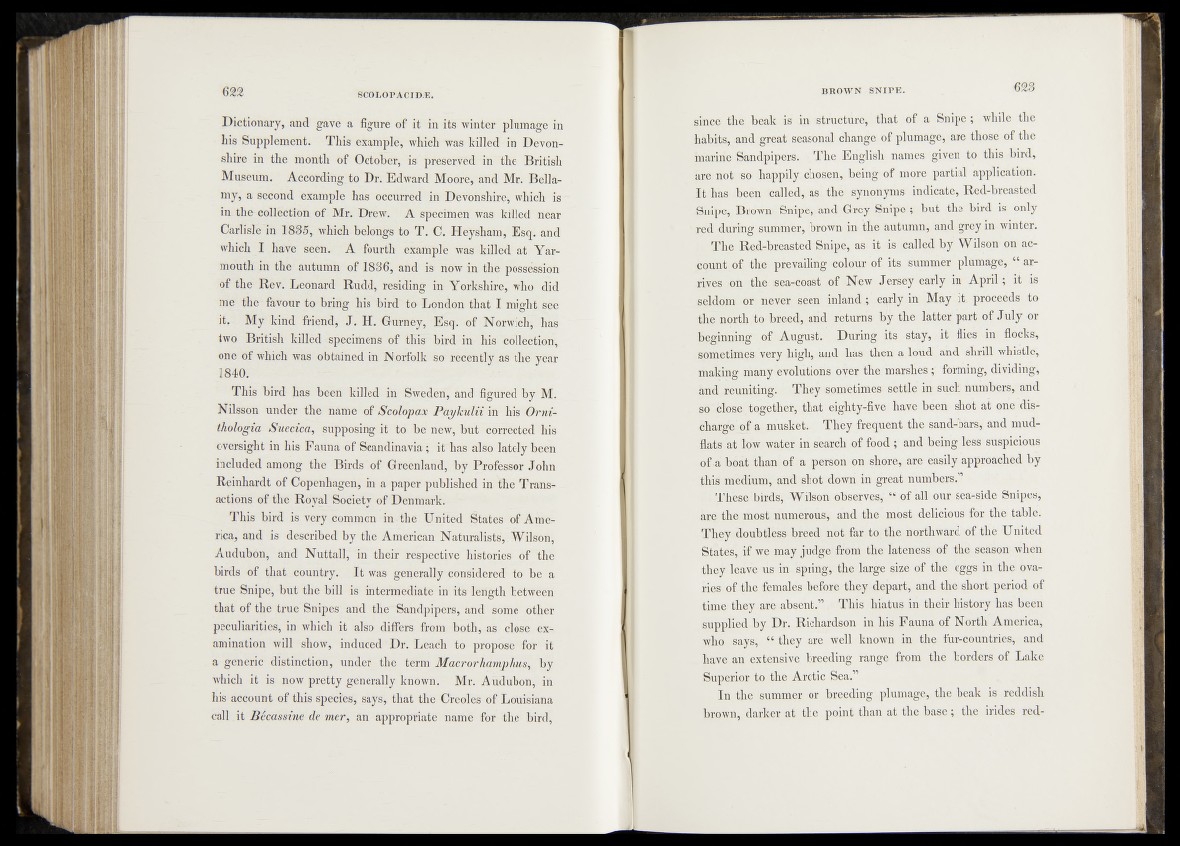
Dictionary, and gave a figure of it in its winter plumage in
his Supplement. This example, which was killed in Devonshire
in the month of October, is preserved in the British
Museum. According to Dr. Edward Moore, and Mr. Bellamy,
a second example has occurred in Devonshire, which is'
in the collection of Mr. Drew. A specimen was killed near
Carlisle in 1835, which belongs to T. C. Heÿsham, Esq. and
which I have seen. A fourth example was killed at Yarmouth
in the autumn of 1836, and is now in the possession
of the Rev. Leonard Rudd, residing in Yorkshire, who did
me the favour to bring his bird Ho London that I might sçe
it.- My kind friend* J . H. Gurney, Esq. of Norwich; has
two British killed-specimens of this bird in his collection,
one of which was obtained in Norfolk so recently as the Tear
1840.
This bird has been killed in Sweden, and figured by M.
Nilsson under the name of Scolopax Paykulii in his Orni-
thologia Suecica, supposing it to be new, but corrected his
oversight in his Fauna of Scandinavia ; it' has also lately been
included among the Birds crik Greenland, -by Professor John
Reinhardt of Copenhagen, in a paper published in Ihe Trans?- -
actions of the Royal Society of Denmark.
This bird is very common inrthe Ü nited States of America,
and is described by the American N aturalists,. Wilson,
Audubon, arid Nuttall, in their respective histories of tile
birds of that country. It was generally considered ip #1 a
true Snipe, but the bill is intermediate in its length between
that of the true Snipes and the"~Sandpipers, and some other
peculiarities, in which it also differs from hpth, as dose examination
will show, induced • Dr. Leach to propose for it
a generic distinction, under the term Macrorhamphus, by
which it is now pretty generally known. Mr. Audubon, in
his account of this species, says, that the Creoles of Louisiana
call. it Bécassine de mer, an appropriate name for4frej bird,
since the beak is in structure, that of a Snipe; while the
habits;,.-and great seasonal change of plumage, are those of the
inaririe Sandpipers. The English names^given to this -bird,
are not so happily; chosen, being; of more partial application.
I t has been called,-as the* synonyms"-indiG^^,,jRed-breasted
Snipe, BrownJSnipe1, and Grey Snipe ;. but the bird is only
steid during, summer, brown in-,the autumn* and-grey in winter.
s^'T-he Red-breasted'Snipe*;1 as. it us called»;by Wilson on ac-
corint^of the prevailing colourlo^ijttS .summer plumage, “ arrives
ion the seaTcoast- of-New Jersey early in April-; it is
seldom or driver seen' inland,; early-in May - it. -proceeds to
the north;to breed, arid returns by the latter part of July or
beginning' of August. During its Stay, dh-flies in flocks,
sometimes l®ry.hdgh, and has then a, loud and shrill* whistle,
making many evolutiSfj^iover the, marshesforming, dividing',
arid reuniting., They sometimes settleiri‘ suriif numbers, arid
so" cliose/togctherj that eighty-five have been shpt at one dis-
chargVof a muskBt. They frequent the ‘sand-bars, and mudflats
at low.water in search ,of food ; and being less suspicious
- of .a boat-than! of R person on shore, are easily approached by
this medium, and' showdown in great numbers.1- ■*- -
ksThesrilbirds, -Wilson observes* “ of all-our seaside Snipes,
ar^Xthe.*most numerous; and the most, deliciOris for the- tablei
They doubtless-breed, not far tpjthej- northward *6^ the 'United
States,,if vtQmay judge from the lateries^- of the Season when
the^rOR^erisOTi.'-Spring, the large size of thesriggs1 in the Ova-
,Sies|o'fcthe females -before. they depart, and the short period of
time they -are .absent,” This hiatus in theirihistory has been
supplied .by Dr. Richardson in his Fauna of North America,
-who. says, “ they are*-well known,;in the fur-countries, and
have an extensive/ breeding range from the borders of Lake
SupgliiSto the ArctiCfSea.”
In the summer or breeding- plumage, the beak is reddish
brown, darker at, the - poink,than at the base; the irides red